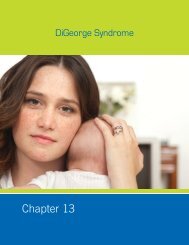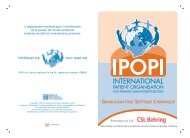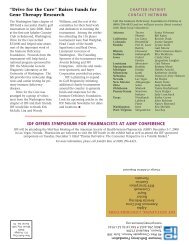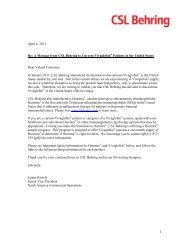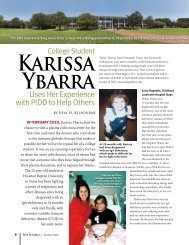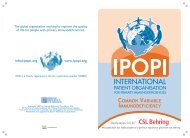IDF Patient & Family Handbook for Primary Immunodeficiency ... - IDFA
IDF Patient & Family Handbook for Primary Immunodeficiency ... - IDFA
IDF Patient & Family Handbook for Primary Immunodeficiency ... - IDFA
Create successful ePaper yourself
Turn your PDF publications into a flip-book with our unique Google optimized e-Paper software.
90 General Care<br />
General Care During Specific Illness continued<br />
Always notify your physician when you suspect your<br />
child has croup. Your physician may recommend<br />
that the child be seen immediately.<br />
Acute Coryza (Common Cold)<br />
Acute coryza (common cold) is an acute<br />
inflammation of the upper respiratory tract (nose<br />
and throat or nasopharynx). Early symptoms<br />
include a dry tickling sensation in the throat,<br />
followed by sneezing, coughing and increased<br />
amounts of nasal discharge. There may also be<br />
symptoms of fatigue, chills, fever and general<br />
aches and discom<strong>for</strong>t.<br />
Influenza (Flu)<br />
Influenza (flu) is a term used to describe a highly<br />
contagious respiratory infection which is caused<br />
by three closely related viruses. Influenza may<br />
occur sporadically or in epidemics. Usually<br />
epidemics occur every two to four years and<br />
develop rapidly because of the short incubation<br />
period. The incubation period includes the time<br />
a person is exposed to an infecting agent to the<br />
time symptoms of the illness appear. Symptoms<br />
of the flu include sudden onset of high fever;<br />
chills, headache, weakness, fatigue, rhinitis, and<br />
muscular soreness. Vomiting and diarrhea may<br />
also be present with one type of influenza.<br />
Acute Bronchitis<br />
Acute Bronchitis is an inflammation of the bronchi<br />
(the major branches off the trachea or windpipe).<br />
It often accompanies or follows an upper<br />
respiratory tract infection, such as the common<br />
cold. Symptoms include fever and cough. At the<br />
onset, the cough is dry, but gradually becomes<br />
productive (producing mucus).<br />
Pneumonia<br />
Pneumonia is an acute infection of the lungs and<br />
can be caused by bacteria, viruses, and fungi.<br />
Symptoms include chills, high fever, cough,<br />
and chest pain associated with breathing and<br />
coughing. In some cases nausea, vomiting, and<br />
diarrhea may also occur. <strong>Patient</strong>s who develop<br />
pneumonia must be treated by a physician since<br />
permanent lung damage may develop if it is not<br />
treated aggressively.<br />
General Care of the Individual with<br />
Respiratory Illness<br />
The treatment of respiratory infections is directed<br />
toward the relief of symptoms and the prevention<br />
of complications. Your doctor may prescribe<br />
a medication to relieve fever and general body<br />
aches. Antibiotics may be prescribed to control<br />
infections of bacterial origin and/or to prevent<br />
complications. Expectorants may be prescribed<br />
to liquefy (water down) mucus secretions.<br />
Decongestants to shrink swollen mucous<br />
membranes may also be ordered. Fluids should be<br />
encouraged, and drinking a variety of beverages is<br />
important. Beverages served with crushed ice can<br />
be soothing to a sore throat. Warm beverages,<br />
such as tea, may promote nasal drainage and<br />
relieve chest tightness.<br />
During the acute phase of any illness, there may<br />
be an initial loss of appetite. You or your child<br />
should not be <strong>for</strong>ced to eat, and large meals<br />
should not be offered. It is often better to offer<br />
small frequent feedings of liquid and soft foods.<br />
Once the appetite returns, a high-caloric, high<br />
protein diet, to replace the proteins lost during the<br />
acute phase of the illness, should be offered (see<br />
section in this chapter titled Nutrition).<br />
General com<strong>for</strong>t measures also include rinsing<br />
the mouth with plain water at regular intervals.<br />
This will relieve the dryness and “bad taste” that<br />
often accompanies illness and mouth breathing.<br />
A vaporizer is helpful in increasing room humidity.<br />
If you use a vaporizer; it must be kept clean, to<br />
prevent contamination with molds and bacteria.<br />
A petroleum jelly coating can provide relief<br />
and protection to irritated lips and nose. Body<br />
temperature fluctuations may be associated with<br />
periods of perspiration. Bed linens and clothing<br />
should be changed as often as necessary,<br />
and your child should be protected from drafts<br />
and chills. Finally, adequate rest is important.<br />
If persistent coughing or post nasal drip interferes<br />
with rest, elevation of the head and shoulders<br />
with extra pillows during periods of sleep should<br />
be attempted.<br />
The individual should be encouraged to cover the<br />
mouth and nose when sneezing and coughing.<br />
Soiled tissues should be promptly discarded.<br />
Frequent hand washing is essential to prevent<br />
the spread of the infection. In some cases of<br />
bronchitis and pneumonia (depending on the<br />
age and level of understanding) coughing and<br />
breathing deeply at regular intervals should be<br />
encouraged. Coughing protects the lungs by<br />
removing mucus and <strong>for</strong>eign particles from the<br />
air passages. Deep breathing promotes full<br />
expansion of the lungs, reducing the risk of further<br />
complications. In some situations, a physician<br />
may order chest postural drainage, chest<br />
physiotherapy, or sinus postural drainage.







